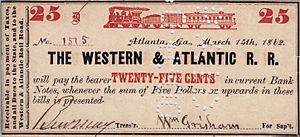Western and Atlantic Railroad facts for kids
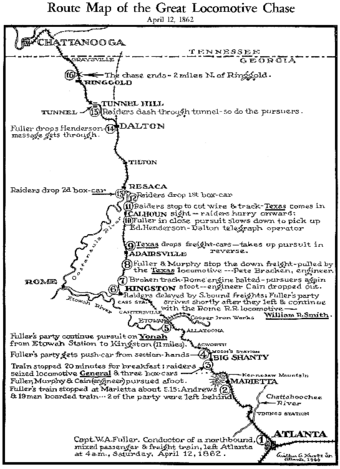
Map of the W&A, with locations of different events in the Great Locomotive Chase marked. The road did not extend beyond Atlanta and Chattanooga prior to its lease to the NC&StL.
|
|
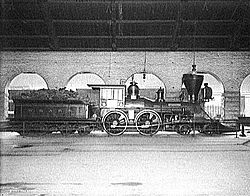
One of the W&A's famous locomotives, The General, on display in the railroad's Union Depot in Chattanooga
|
|
| Overview | |
|---|---|
| Headquarters | Atlanta, Georgia |
| Reporting mark | W&A |
| Locale | Tennessee, Georgia |
| Dates of operation | 1836–present |
| Successor | Nashville, Chattanooga and St. Louis Railway |
| Technical | |
| Track gauge | 4 ft 8 1⁄2 in (1,435 mm) standard gauge |
| Previous gauge | 5 ft (1,524 mm) and 4 ft 9 in (1,448 mm) |
| Length | 138 miles (222 km) |
The Western & Atlantic Railroad of the State of Georgia (W&A) is a railroad owned by the State of Georgia. Today, it is operated by CSX and runs through the Southeastern United States. The line connects Atlanta, Georgia, to Chattanooga, Tennessee.
This railroad was started on December 21, 1836. The city of Atlanta actually began as the end point (or "terminus") for the W&A. A special marker, called the Atlanta Zero Mile Post, shows this original spot. The State of Georgia still owns the line from Atlanta to CT Tower in Chattanooga. It is currently leased and operated by CSX Transportation.
The W&A line is famous for an event called the Great Locomotive Chase. This exciting chase happened during the American Civil War on April 12, 1862. The line was originally built with a 5 ft (1,524 mm) gauge, which was wider than many other railroads.
Contents
Building the Railroad: A Link to the Midwest
In 1836, the government of Georgia, called the Georgia General Assembly, decided to build the Western & Atlantic Railroad. Their goal was to create a direct link between the port city of Savannah and the Midwest. The first part of the railroad was planned to go from Chattanooga to a spot east of the Chattahoochee River. This area is now part of Fulton County.
The idea was for the W&A to eventually connect with other railroads. These included the Georgia Railroad from Augusta and the Macon and Western Railroad from Macon to Savannah. An engineer was chosen to find the best place for the W&A line to end. He picked a spot near what are now Forsyth and Magnolia Streets and placed a stake there. This became the "zero milepost."
In 1842, the zero milepost was moved to a new spot near Underground Atlanta. A small town grew up around this railroad end point. It was first called "Terminus," meaning "end of the line." In 1843, this settlement became the city of Marthasville. Just two years later, in 1845, the city was renamed "Atlanta." The railroad played a huge role in helping north Georgia grow and develop.
How the Railroad Helped Fund Schools
In 1857, Joseph E. Brown became the Governor of Georgia. He believed that free public education was important for the state's growth. Governor Brown wanted to use some of the money earned by the state-owned Western & Atlantic Railroad to help pay for schools. At first, many wealthy landowners did not support public education. They preferred to pay for private teachers for their own children.
Also, the railroad was not making much money at that time. This made it hard for Governor Brown to get the funds he needed for schools. In 1858, Governor Brown chose John W. Lewis to manage the railroad. Lewis was a skilled businessman. He quickly made changes to improve the railroad's finances.
Thanks to Lewis's efforts, the railroad became very profitable. Within three years, it was bringing in $400,000 each year for the state. This money helped support the state's goals, including public education.
Leasing the Railroad: A Long History
Until 1870, the Western & Atlantic Railroad was known as the "State Road." The state directly managed it. On December 27, 1870, a group of 23 investors leased the railroad from the state. This group included Georgia's wartime governor, Joseph E. Brown. They paid $25,000 per month to use the tracks and trains.
This first lease lasted for 20 years. After that, the Nashville, Chattanooga and St. Louis Railway (NC&StL) leased the railroad for 29 years. When the NC&StL took over, the railroad was in poor condition. Many of the older trains were not usable, and most of the freight cars had to be thrown away.
A new rule in the 1890 lease said that any improvements made by the company leasing the railroad would become the state's property. This included new tracks, buildings, and even new trains. The NC&StL continued to lease the W&A until it became part of the Louisville and Nashville Railroad. This railroad later joined the Atlantic Coast Line, which eventually became part of CSX Transportation.
Today, CSX Transportation still operates the line as the Western & Atlantic Subdivision. CSXT signed its current lease with Georgia in May 1986. This lease was set to end on December 31, 2019. However, in September 2018, CSX and the state agreed to renew the lease for another 50 years, starting in 2020. The new lease costs $1 million a month, with the price going up each year.
During the American Civil War, after the Union army captured the line in mid-1864, the United States Military Railroad briefly operated it until the war ended in 1865.
Distances of Depots from Atlanta (1867 and 2008)
| # | Name | Milepost (1867) | Milepost (2008) | Notes |
| 1 | Marietta, Georgia | 20 | 20 | begun in 1838, completed 1842 |
| 2 | Big Shanty-renamed Kennesaw, Georgia approx. 1870 | 28 | 28 | Chase starts in front of the Lacy Hotel |
| 3 | Acworth, Georgia | 35 | 35 | |
| 4 | Allatoona, Georgia | 40 | 40 | Near Lake Allatoona |
| 5 | Emerson, Georgia | 45 | 45 | |
| 6 | Cartersville, Georgia | 47 | 47 | |
| 7 | Cass Station-unincorporated Cassville, Georgia | 52 | 52 | |
| 8 | Kingston, Georgia | 59 | 59 | |
| 9 | Adairsville, Georgia | 69 | 69 | |
| 10 | Calhoun, Georgia | 79 | 79 | |
| 11 | Resaca, Georgia | 84 | 84 | |
| 12 | Tilton-unincorporated Dalton, Georgia | 90 | 90 | |
| 13 | Dalton, Georgia | 99 | 99 | |
| 14 | Tunnel Hill, Georgia | 107 | 108 | Chetoogeta Mountain Tunnel completed May 7, 1850; first passenger trains arrived October 31, 1849; first through passenger train passed through May 7, 1850 |
| 15 | Ringgold, Georgia | 115 | 114 | Chase ends at 116.4 |
| 16 | Graysville, Georgia | 121 | 121 | |
| 17 | Chickamauga, Georgia | 126 | 126 | |
| 18 | Chattanooga, Tennessee | 138 | OWA 137.3/OOJ 149.4 | End W&A Sub, End Chattanooga SD (at Wheland, completed Dec. 1849 |
In 1867, trains left Atlanta at 8:50 a.m. and 7 p.m. They arrived there at 1:35 a.m. and 1:15 p.m. Not much has changed on the tracks since then. Some parts of the track have been slightly moved to improve clearances and overall quality.
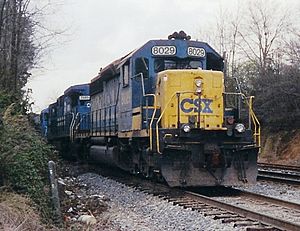
The Great Locomotive Chase: A Civil War Story
On the morning of April 12, 1862, during the Civil War, the locomotive General stopped at Big Shanty, Georgia (now Kennesaw). The crew and passengers got off to eat breakfast. While they were eating, a group of Union spies, led by James J. Andrews, stole the General. These spies are known as Andrews' Raiders.
The raiders cut telegraph lines and pulled up some rails to slow down anyone chasing them. They also tried to burn a covered bridge, but they failed. The train's conductor, William A. Fuller, immediately began to chase the General. He ran on foot and then used a small handcar.
At Emerson, Georgia, Fuller took over another locomotive called the Yonah and rode it north to Kingston, Georgia. At Kingston, Fuller got a third locomotive, the William R. Smith, and continued the chase towards Adairsville. The raiders had broken the tracks about two miles (3.2 km) south of Adairsville, so Fuller had to run those two miles on foot.
At Adairsville, Fuller got a fourth locomotive, The Texas, and continued chasing the General. The Texas had to chase the General while moving backward! The chase went through Dalton, Georgia, and Tunnel Hill, Georgia.
Near Ringgold, Georgia, at milepost 116.3, Andrews' Raiders finally abandoned the General. They scattered into the woods, just a few miles from Chattanooga. After the chase, Andrews and most of his raiders were caught. They faced serious consequences for their actions. Some of the raiders managed to escape, and others were exchanged as prisoners of war. These men were among the first soldiers to receive the Medal of Honor, a very brave award.
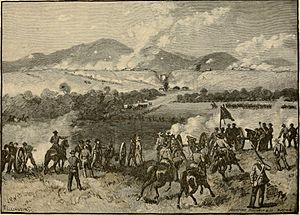
After the Chase: The Locomotives' Journeys
After the famous chase, both the General and the Texas locomotives went back to work. The General served the W&A for many years. Later, it was moved to the Nashville, Chattanooga and St. Louis Railway Union Depot in Chattanooga.
In 1890, the Nashville, Chattanooga and St. Louis Railway fixed up the General. They used it for public events and to teach people about the Civil War history of the railroad. This helped bring tourists to the area until the 1930s. In 1962, 100 years after the chase, the L&N railroad made the General able to run on its own power again. It made special trips to celebrate the 100th anniversary of Andrews' Raid.
The most important trip was its run from Atlanta to Chattanooga on the Western & Atlantic Railroad. After this, the General traveled around the eastern U.S. for many years. In the late 1960s, there was a disagreement about where the General should be kept. After a legal decision in 1971, the General was moved to Kennesaw, Georgia, in 1972. It is now on display at the Big Shanty Museum.
The Texas locomotive was renamed Cincinnati after the chase. It was retired from service not long after 1900. It was stored for a while and then moved to Grant Park in 1911. Later, it was placed in the Atlanta Cyclorama museum.
Changing the Track Size (Re-gauging)
- Further information: Track gauge in the United States#5 ft (1,524 mm) gauge and Confederate railroads in the American Civil War
Before the Civil War, most railroads in the Southern United States used a rail gauge of 5 ft (1,524 mm). This was a wider track size. In 1886, it was decided that all railroads should change to the Northern standard gauge of 4 ft 8 1⁄2 in (1,435 mm).
The W&A railroad completed this huge change along all 138 miles (222 km) of its tracks in less than 24 hours! The work started at 1:30 p.m. on May 31 and finished by 10 a.m. the next morning. Over 400 men worked to pry up one rail and move it closer to the other by exactly 3 inches (76 mm). This made the new track size 4 ft 9 in (1,448 mm). The General and many other locomotives also had their wheels adjusted to fit the new track size at this time.
The W&A in Modern Times
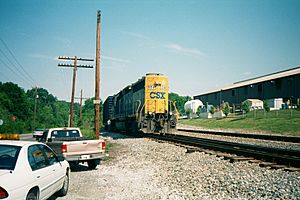
The Western & Atlantic Railroad has not changed much since 1862. The Nashville, Chattanooga and St. Louis Railway made a few small changes to the track layout. One big change happened when Lake Allatoona was created. The tracks that went through Allatoona Pass were removed and realigned. The bridge over the Etowah River has also been replaced.
The famous Chetoogeta Mountain Tunnel in Tunnel Hill, Georgia, was closed in 1928. It was too small for the larger trains of that time. A new tunnel was built nearby to handle modern trains.
Today, you can find a marker near the Big Shanty Museum in Kennesaw, Georgia, showing where the Great Locomotive Chase began. Another marker is at Milepost 116.3, north of Ringgold, Georgia, where the chase ended. This is close to the recently restored train station at Milepost 114.5. There is also a monument dedicated to Andrews' Raiders at the Chattanooga National Cemetery. It has a model of the General on top and tells a short history of the chase.
Images for kids
-
One of the W&A's famous locomotives, The General, on display in the railroad's Union Depot in Chattanooga
-
CSXT 8029 is waiting for another train at the siding at Tunnel Hill, Georgia, on the Western & Atlantic Sub.
-
Battle of Allatoona Pass, 1864, for control of the line
-
CSXT GP40-2 6046 is shown working the CSX Tyner Branch on the Western & Atlantic Sub; the Tyner Branch leads to the old Volunteer Army Ammunition Plant which now leads to the Volkswagen Chattanooga Assembly Plant.


